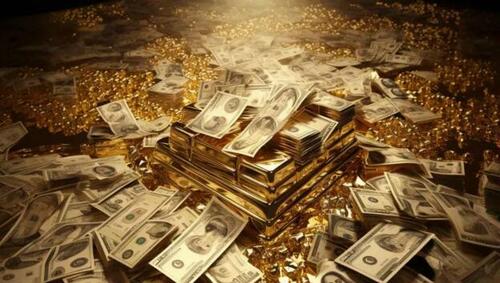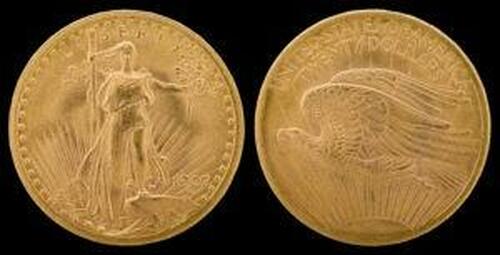
Should The Dollar Be Backed By Gold?
Authored by Jacob Hornberger via The Future of Freedom Foundation,
Amidst all the talk about the Federal Reserve’s high interest-rate policy to combat its many years of monetary expansion and debasement, some people advocate the restoration of the monetary system on which the United States was founded — one in which, they say, the dollar was “backed by gold.”

But there is one great big flaw in that idea: Under America’s founding monetary system, the dollar never was “backed by gold.” Instead, the official money of the nation for more than 125 years was gold coins and silver coins. Those coins didn’t back anything because they constituted the nation’s official money itself.
The Framers wanted nothing to do with paper money. They knew that historically paper money had been the way that governments had plundered and looted people through monetary expansion — that is, inflation of the paper-money supply. By printing up ever-increasing amounts of paper money to fund its operations, the government’s inflation of the money supply would cause the value of everyone’s money to fall. That decrease in value would be reflected in rising prices of the things that money would buy.
At the time the Constitution was being proposed, Americans themselves had just recently experienced the ravages of inflation with the paper money that the Revolutionary Congress had issued during the Revolution. The basic unit of money during that time was called the Continental. The Revolutionary Congress printed so many Continentals that the value of everyone’s money dropped to near zero. A popular refrain became “Not worth a Continental.”
Thus, the Framers wanted to come up with a monetary system that prevented government officials from debasing the value of people’s money. They knew that a paper-money system would not be likely to accomplish that goal. So, they came up with a system in which the official money of the country would be gold coins and silver coins. They knew that government officials could not print up vast quantities of gold coins and silver coins, like they could do with paper money.
The Constitution called into existence a government of limited powers. Its powers were limited to those powers that were enumerated in the Constitution. If a power wasn’t enumerated, it could not be exercised.
Thus, the Constitution granted the federal government the power to coin money. Obviously, paper cannot be coined. On the other hand, gold and silver can be coined.
During that time, paper money was known as “bills of credit.” The Constitution did not grant the federal government the power to issue “bills of credit” or paper money. Therefore, the federal government could not issue paper money. Since it was empowered only to coin money, the government issued gold coins and silver coins as the official money of the United States. That went on for more than 125 years.
Under the Constitution, the states were in a different position. They had the inherent powers of government that had characterized governments throughout history — the traditional “police powers” to provide for the health, safety, morals, and welfare of the people. However, there was an exception to such powers — if the Constitution prohibited the states from exercising a particular power, they were precluded from doing so.
That’s what the Constitution did with respect to the states’ monetary powers. States were expressly prohibited from issuing “bills of credit” or paper money. They were also expressly prohibited from making anything but gold and silver legal tender.

1907 $20 gold coin.
The Constitution also empowered the federal government to borrow money. That meant the government could issue bills, notes, and bonds. But even though the bills would oftentimes circulate in payment of goods and services, everyone understood that they were promises to pay money, not money itself. The money these instruments of indebtedness promised to pay was gold coins and silver coins, the official money that had been established by the Constitution.
The principle was the same with respect to bills, notes, and bonds issued by state governments. They were all promises to pay gold coins and silver coins, not paper money “backed by gold.”
This gold-coin/silver-coin monetary system turned out to be the finest monetary system in history, one in which the federal government did not plunder and loot people through inflation for more than 125 years.
The stability of this monetary system was one of the major contributing factors in the tremendous increase in the standard of living of the American people, especially by the time of the end of the 19th century and the early part of the 20th century.
It all came to an end in the 1930s, when the Franklin Roosevelt administration decreed an end to America’s gold-coin/silver-coin system and replaced it with an irredeemable paper-money system.
What was amazing is that FDR did this without even the semblance of a constitutional amendment and, just as bad, that the Supreme Court let him get away with it.
The result has been the same as it has been throughout history — the plundering and looting of people through monetary debasement.
Is the solution to implement a monetary system in which the dollar is “backed by gold”? No! As the Nobel Prize-winning libertarian economist Friedrich Hayek proposed, the solution is to separate money and the state. That means the repeal of legal-tender laws, the abolition of the Federal Reserve, and the end of all governmental involvement in money.
Let the free market decide the concept of money. The free market produces the best of everything. It would produce a monetary system that would be even better than the gold-coin/silver-coin system on which our nation was founded and which lasted for more than a century.
Tyler Durden
Mon, 08/26/2024 – 20:05













![Gmina Olsztynek i Stawiguda. Policjanci szukali promili, a znaleźli... tylko czyste sumienia [ZDJĘCIA]](https://static.olsztyn.com.pl/static/articles_photos/43/43550/27fda88aec99d7ee4a2c0283314bfb05_220x165.jpg)

